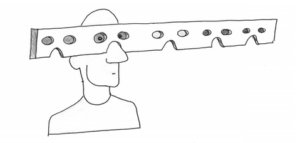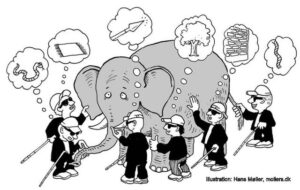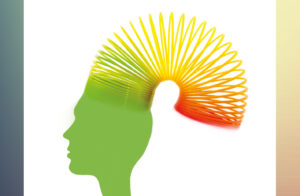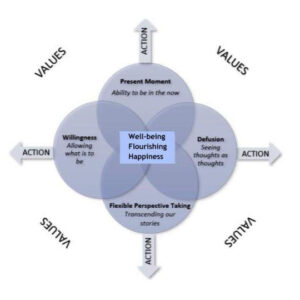FLEXIBLE PERSPECTIVE TAKING
 Ever since you were an infant, you have almost certainly been trained to tell stories about who you and others are and why you do what you do. What’s your name? What do you like? What do you feel? What are they like? Why did you do that?
Ever since you were an infant, you have almost certainly been trained to tell stories about who you and others are and why you do what you do. What’s your name? What do you like? What do you feel? What are they like? Why did you do that?
These are questions you have been asked and have answered countless times since acquiring language. We get reinforced for telling consistent stories that explain and justify our behaviour, and we get corrected if we tell stories that are inconsistent or don’t make sense to the people around us. For example, a child who repeatedly says they like trucks, but then one day says they hate trucks, will likely get some correction such as, “No, Emma, remember, you like trucks!” Over time we learn to tell more and more consistent stories that seem to describe ourselves, others, the world, and how all these things work.
The stories that others tell about us and those that we tell about ourselves are interwoven to form an interlocking tapestry of meaning that is very robust and slow to change. We learn that we are an “angry person” or a “girl” or a “Brit” or “good at writing.” Without our awareness, we strive to act in line with our self-concept and avoid acting against it.
When the consistency that is fostered is helpful, then these stories work great. But these stories can also be like glue that binds us to old ways of being when what we really need is change. For example, consider how a person who tends to think poorly of themself (i.e., has “low self-esteem”) typically responds when someone else tries to tell them that they are actually a “good person.” Do they think, “Really? Wow, I never thought of that!” and from then on believe they are a worthwhile person? That outcome is so unlikely as to seem absurd. No, instead their mind will probably generate arguments (either out loud or privately) about their worthlessness. We all do this in some way, fighting to maintain consistency in our explanations or stories. This thinking, this defense of one’s story about oneself, might be called our “self-concept”, and it’s often a fairly fixed and inflexible entity.
Rather than being able to observe these stories as what they are—attempts to explain and understand ourselves and the world that are necessarily incomplete and limited—we see ourselves and others from the perspective of these stories and thereby can become controlled and constricted by them. Let me give you a recent example from my own life to illustrate this.
OUR DEFAULT EXPLANATORY MINDS ARE LIMITED AND SOMEWHAT RIGID
 A few days ago I got an email from a client that I had worked with about five years ago. It was a lovely email. This individual had moved back to their country of origin in the interim (which had been the reason for us breaking off our sessions), achieved some goals and success in his valued life directions (in his case: a creative field), as well as getting married to his long-term partner. It ended on a complimentary note, and the request for us to continue working together:
A few days ago I got an email from a client that I had worked with about five years ago. It was a lovely email. This individual had moved back to their country of origin in the interim (which had been the reason for us breaking off our sessions), achieved some goals and success in his valued life directions (in his case: a creative field), as well as getting married to his long-term partner. It ended on a complimentary note, and the request for us to continue working together:
“You’re the best therapist I’ve ever had, by far, and I was wondering these days, since everyone is doing everything online, if there’s any way you’d be willing to pick up our sessions virtually.”
I was happy to do so, and wrote back accordingly, also mentioning my pleasure in the fact that he had had five good and productive years since we had last spoken.
I didn’t receive a reply to my email, which I found puzzling as this person had seemed really eager to renew our acquaintance, and continue the work we’d started five years previously.
WHY DEFAULT/RIGID THINKING ONLY LEADS TO SUFFERING
 I mention this personal anecdote just to underline something that is pretty prevalent for most of us in one form or another. Something (an email exchange, a phone call, a relationship, a work project) seems to be going one way, and then suddenly it changes direction and goes another way. When this happens, we are alerted to this fact by either confusion (as was the case with me) or some other “negative” emotion (anxiety, disappointment, frustration). Another thing that often happens when these big or small changes occur in our lives is that our minds often go into diagnosis, analysis, and problem-solving mode. The two main ways in which the mind does this is either through criticism or blame, both of ourselves, or someone else.
I mention this personal anecdote just to underline something that is pretty prevalent for most of us in one form or another. Something (an email exchange, a phone call, a relationship, a work project) seems to be going one way, and then suddenly it changes direction and goes another way. When this happens, we are alerted to this fact by either confusion (as was the case with me) or some other “negative” emotion (anxiety, disappointment, frustration). Another thing that often happens when these big or small changes occur in our lives is that our minds often go into diagnosis, analysis, and problem-solving mode. The two main ways in which the mind does this is either through criticism or blame, both of ourselves, or someone else.
Think about something that’s gone “wrong” in your life recently, something big or small. Now ask your mind to supply a reason for why this happened. I would imagine that whatever your mind comes up with, it’s reason, explanation, or story for why this happened will either translate as some form of self-criticism, or will attempt to blame something or someone else.
I would be very surprised if your mind responded in a dispassionate, relaxed way (especially if this event was unexpected and unwanted), but sometimes the mind does go: “Hey, that’s just how it goes” or “You win some, you lose some” without giving you any explanation for the irksome event or situation. If it does that, lucky you! And in that case, especially if it does this frequently, you probably do not need to read on. But if your mind often gets critical, either towards others or yourself, you might the following reflections and suggestions useful.
WHAT OUR MINDS DO WHEN THEY’RE TRYING TO FIGURE SOMETHING OUT
 My mind was not disinterested or dispassionate about this non-reply. Instead, it went into default explanation-seeking mode, and started worrying that perhaps I hadn’t responded effusively enough to my client’s good news, or perhaps I’d responded too effusively.
My mind was not disinterested or dispassionate about this non-reply. Instead, it went into default explanation-seeking mode, and started worrying that perhaps I hadn’t responded effusively enough to my client’s good news, or perhaps I’d responded too effusively.
Either way, my mind was resolved initially to criticise me. And in a similar vein: maybe something else in the email, something uttered in a friendly and hopefully engaging way had triggered some sort of antipathy that hadn’t been there before? Again, another form of self-criticism veiled as an objective explanation.
My mind also helpfully reminded me that this person was or had-been quite indecisive when we had worked together, as many of us are, and perhaps they had simply changed their mind (i.e. other-focused criticism/analysis). But that didn’t sufficiently explain why this person hadn’t written back, even to acknowledge my reply.
After a week of occasionally thinking about this riddle, my mind, always the problem-solver, suggested I perhaps send a brief follow-up email just checking to see if my reply hadn’t perhaps gone astray and landed in a Spam folder, as well as reassuring the other person that if they had changed their mind, that was fine too. Again, no reply.
Although I found this very puzzling which is perhaps easier to deal with than something we find more aversive, this low-level discomfort reminded me of two important things:
a) when something happens to us that we don’t like, or is unexpected, our minds usually turn on us (it’s your fault) or turn on another person or system or situation (it’s their fault) – none of which is necessarily helpful
b) whichever way our mind has “understood” the situation (even though it is working here purely on hypothesis and abstract thinking, as there would be no way for me to verify the above thoughts) the mind usually sticks quite rigidly to the explanations it’s come up with, and if someone else offers an alternative explanation, the mind will usually disagree with the alternative explanation, even if the alternative is no more founded on objective FACT than the mind’s own explanation
Once I had decided that either this person was being a bit flakey (other-focused blame) or that maybe I had responded inappropriately or insufficiently (self-blame), any other equally viable explanation for why I hadn’t received a reply (of which there are many – see below) was not taken into consideration, or even hypothesized about at that point.
And yet of the two explanations my mind had chosen for me to hold onto as the-probable-reason for the non-reply, neither of them were particularly useful to me. If I hadn’t responded appropriately, I would never know what phrasing in my response caused the other person to cut off communication. And to decide that they were “flakey” in some way as a reason to explain their actions, may have been an unfair estimation of my former client, and also quite untrue for their particular circumstances or situation at the time.
Whatever this person’s reason was, and I shall probably never know now, what I do know is that thinking about all the other reasons why they might have acted in this way, rather than just the two “default” explanations from my mind (you’re to blame, he’s to blame) allowed me to feel more at ease with what had happened, as well as give my brain a bit of a rest in terms of trying to shore up and “prove” to me that its default self-blame/other-blame was in fact the Authorised, Unvarnished Truth with a capital T.
Rigid thinking can only imprison the mind in a binary box of self-blame or other-blame (neither of which are especially helpful or pleasant to dwell on), whereas more flexible thinking can make the space for thoughts about this person/topic feel less restricted and claustrophobic.
WHAT IS PSYCHOLOGICAL FLEXIBILITY?
 Many of you are probably familiar with the saying, often attributed to Albert Einstein, that psychopathology is “doing the same thing over and over again but expecting different results.”
Many of you are probably familiar with the saying, often attributed to Albert Einstein, that psychopathology is “doing the same thing over and over again but expecting different results.”
While perhaps overly simplified, inside this saying is an important truth that has been borne out now by thousands of studies—inflexibility and rigidity are at the heart of suffering and pretty much all mental health issues (Chawla & Ostafin, 2007; Spinhoven, Drost, de Rooij, van Hemert, & Penninx, 2014).
In most situations like the one described above, we really need to be able to be flexible and responsive in order to adapt to life’s changing demands, and also to give ourselves and others a break, rather than break ourselves or others in trying to understand the reason for why we or they do the things we do.
Psychological flexibility is a way of talking about the capacity to respond adaptively to the challenges that life presents in ways that fit with our values. Have a look at the following picture which illustrates this concept of psychological flexibility and how it fits into what we know about the processes that promote psychological well-being, flourishing, or happiness.

As depicted in the diagram above, there are four main processes involved in psychological flexibility that contribute to our well-being and happiness:
1. Willingness: Allowing what is to be
2. Defusion: seeing thoughts as thoughts, and as our core selves being separate in awareness, and possibly in behaviour from our mind’s thoughts, urges, suggestions, responses
3. Present Moment: ability to be in the now, rather than lost in a hypothetical future or the past
4. Flexible Perspective Taking: “transcending our stories” is how this is summarised in the diagram above, which is taken from a book by LeJeune and Luoma (2019). I prefer to think of this less about “transcending” (which suggests escaping, or abandoning, or leaving behind our own thoughts and explanations, which I’m not sure the mind is in fact capable of doing) and more about becoming more expansive or pluralistic in the stories or explanations we give ourselves, making sure to include our default self/other-blame narratives, but giving them equal weighting in terms of all the other stories our minds spin us.
WHY MIGHT WE DECIDE TO DO THIS?
 The ability to notice the presence of the stories we have about our- selves, others, and the world, and subsequently take on various perspectives, is what allows us to transcend or at least recognise the numerous and diverse options that are available to our minds in order to understand something, beyond the couple of explanations/ stories our minds seem to come bundled with.
The ability to notice the presence of the stories we have about our- selves, others, and the world, and subsequently take on various perspectives, is what allows us to transcend or at least recognise the numerous and diverse options that are available to our minds in order to understand something, beyond the couple of explanations/ stories our minds seem to come bundled with.
Doing this gives us more space to create lives based on our values rather than following a predetermined mind-explanation or plot. Perhaps the ultimate perspective shift is to be able to contact perspective itself— that is, the perspective of oneself as observer.
Writings about mindfulness from many traditions have described this sense of perspective using terms like “pure awareness,” “the silent witness,” “original nature,” “pure consciousness,” or “the observing self.” As I write this, my stomach feels somewhat bloated from something I ate the night before. I feel uncomfortable, and my mind is already doing its self-blame thing (why did you eat so much X!?!), but there is also part of me (and you) that is just noticing the responsive or reactive side of me tussling with thoughts and feelings in reaction to my bodily discomfort. That is the observing self, or the place of awareness, simply put.
There is also another, more commonsense way in which flexible perspective taking can be helpful. We can learn to see ourselves and our experiences from different vantage points, whether in space, in time, or even from the perspective of other people. Being able to shift perspective in this way can help free us up to see new possibilities for how to respond in our lives. It can open up a space for new choices for what we might value in our lives that is unconstrained by the stories we tell.
HOW TO DO THIS?
 There are lots and lots of ways of doing this, and if this is something that interests you, let’s have a chat in our sessions where we can find some practices that might work for you. Also see the bibliography below for some books/articles. But here’s a really simple practice you can try which is one I used on my confused, perplexed mind after it was still churning around thoughts about the unreceived email. I call this process perspective-amplification, and this is how it works:
There are lots and lots of ways of doing this, and if this is something that interests you, let’s have a chat in our sessions where we can find some practices that might work for you. Also see the bibliography below for some books/articles. But here’s a really simple practice you can try which is one I used on my confused, perplexed mind after it was still churning around thoughts about the unreceived email. I call this process perspective-amplification, and this is how it works:
PERSPECTIVE AMPLIFICATION INSTRUCTIONS
1) Think of something that’s worrying you, or that you’re concerned about.
2) See where your mind takes you, in default mode on this: does it blame you, or blame another person or thing, or something else. Write down your mind’s default “hot-take” using a phrase that begins something like this: My mind is telling me that this happened because…
3) Now, without fighting or disagreeing with your mind, or telling it to think differently, use the same phrase to write down a handful (5) other perspectives. And you can make these as reasonable or unreasonable as you like, the only rule is that the other perspectives need to be a) non-blaming, either of yourself or another person, and b) kind or respectful in some way
So for the situation above, I wrote:
DEFAULT RESPONSES (THE BLAME GAME)
My mind is telling me that I wrote something inappropriate or too-effusive/not-effusive-enough in reply to X’s email.
My mind is telling me that X is being flakey.
OTHER PERSPECTIVES
My mind is telling me that X might have looked at their bank balance after sending me the email and realised that in fact they didn’t have enough money for therapy.
My mind is telling me that maybe they fell ill, or their partner became ill, and so therapy plans were going to have to be shelved until they had the time and mental space to take on this project again.
My mind is telling me that maybe they had found, or had had a recommendation of a therapist closer to them the day after writing but felt bad about saying they were going to use the local therapist, especially after praising my services.
My mind is telling me that perhaps X is depressed or stuck in some way, and wrote this email when they were feeling in a more hopeful, pragmatic headspace; however the day after they maybe sunk back again into lethargy and passivity that often accompanies low mood.
4) Now simply read all the pluralistic perspectives as well as reminding your mind that all of them are equally feasible, plausible, and possible.
And for that reason the mind might try to practice (willingness required here) resting in that very uncomfortable place of Not Knowing, alongside the practice of having patience with ourselves to hold all the explanations and not just favour our first-born thoughts – which is to say the place our minds go to almost without having to even reflect on the matter (our default, knee-jerk or mind-jerk responses).
If your mind struggles to do this, and either pushes you to come up with further explanations or stick religiously and dogmatically to the self-blame, other-blame ones, ask your mind what’s in it for you (in terms of your well-being and peace of mind) and see if you can negotiate and persuade your mind to take a more flexible, open, not-knowing approach, which may in time help it (you) to feel better by not tying you down to something hurtful, upsetting, and possibly unfounded.
Bibliography
Chawla, N., & Ostafin, B. (2007). Experiential avoidance as a functional dimensional approach to psychopathology: An empirical review. Journal of Clinical Psychology, 63(9), 871–890.
Dijk, S. V. (2009). The Dialectical Behavior Therapy Skills Workbook for Bipolar Disorder: Using DBT to Regain Control of Your Emotions and Your Life. New Harbinger Publications.
LeJeune, J., & Luoma, J. B. (2019). Values in Therapy: A Clinician’s Guide to Helping Clients Explore Values, Increase Psychological Flexibility, and Live a More Meaningful Life. New Harbinger Publications.
McHugh, L., & Stewart, I. (2012). The Self and Perspective Taking: Contributions and Applications from Modern Behavioral Science. New Harbinger Publications.
Neff, K. (2011). Self Compassion. Hachette UK.
Spinhoven, P., Drost, J., de Rooij, M., van Hemert, A. M., & Penninx, B. W. (2014). A
longitudinal study of experiential avoidance in emotional disorders. Behavior Therapy,
45(6), 840–850.
